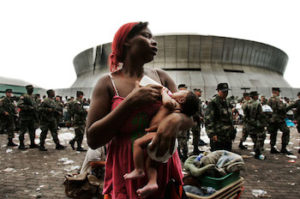
A transformed Super Dome
*On this date in 2005, Hurricane Katrina made landfall and began its devastation on Louisiana, Mississippi, and Alabama; states that are 30% African American.
Formed on August 23rd, Katrina was a Category 5 hurricane that made landfall on Florida and Louisiana until August 31st, causing catastrophic damage, particularly in New Orleans and the surrounding areas, and over 1,200 deaths. Subsequent flooding caused largely as a result of fatal engineering flaws in the flood protection system known as levees around the city of New Orleans precipitated most of the loss of lives.
The storm was the third major hurricane of the record-breaking 2005 Atlantic hurricane season, as well as the fourth-most intense Atlantic hurricane on record (at the time) to make landfall in the contiguous United States, behind only the 1935 Labor Day hurricane, Hurricane Camille in 1969. Many Hurricane Katrina victims faced difficult living conditions even before the storm arrived. Mississippi, Louisiana, and Alabama were, respectively, the nation's first, second, and eighth poorest states. Of the 5.8 million individuals in these states who lived in the areas struck hardest by the hurricane, more than one million lived in poverty before the hurricane’s beginning.
The reference information in this article explains why relief efforts were so important to Katrina victims. Many of the storm’s victims had little or no resources on which to rely in those difficult times. The Census data also confirmed that African Americans comprised a disproportionate share of the hurricane’s victims. About one of every three people who lived in the areas hit hardest by the hurricane was African American. By contrast, one in every eight people in the nation is African American. African Americans living in New Orleans were especially likely to be without a vehicle before the hurricane struck. More than one in three Black households in New Orleans (35 percent) and nearly three in five poor black households (59 percent) lacked a vehicle. Among white non-Hispanic households in New Orleans, 15 percent lacked a vehicle.
